Comprehensive Accounting Report: Financial Analysis Overview
VerifiedAdded on 2020/07/22
|18
|3334
|164
Report
AI Summary
This accounting report provides a comprehensive overview of accounting principles and practices. It begins by exploring the purpose of accounting, emphasizing its importance in providing financial clarity for effective decision-making, and identifies key users of accounting information such as investors, creditors, and government agencies. The report distinguishes between financial and managerial accounting, highlighting their differing objectives and audiences. It then delves into the practical application of accounting through detailed explanations of journal entries, the creation of general ledger accounts, and the preparation of a trial balance. The report concludes with an analysis of financial statements, specifically the income statement and balance sheet, demonstrating how these tools are used to assess a company's financial performance and position. Overall, the report provides a detailed guide to fundamental accounting concepts and their application in the business environment.
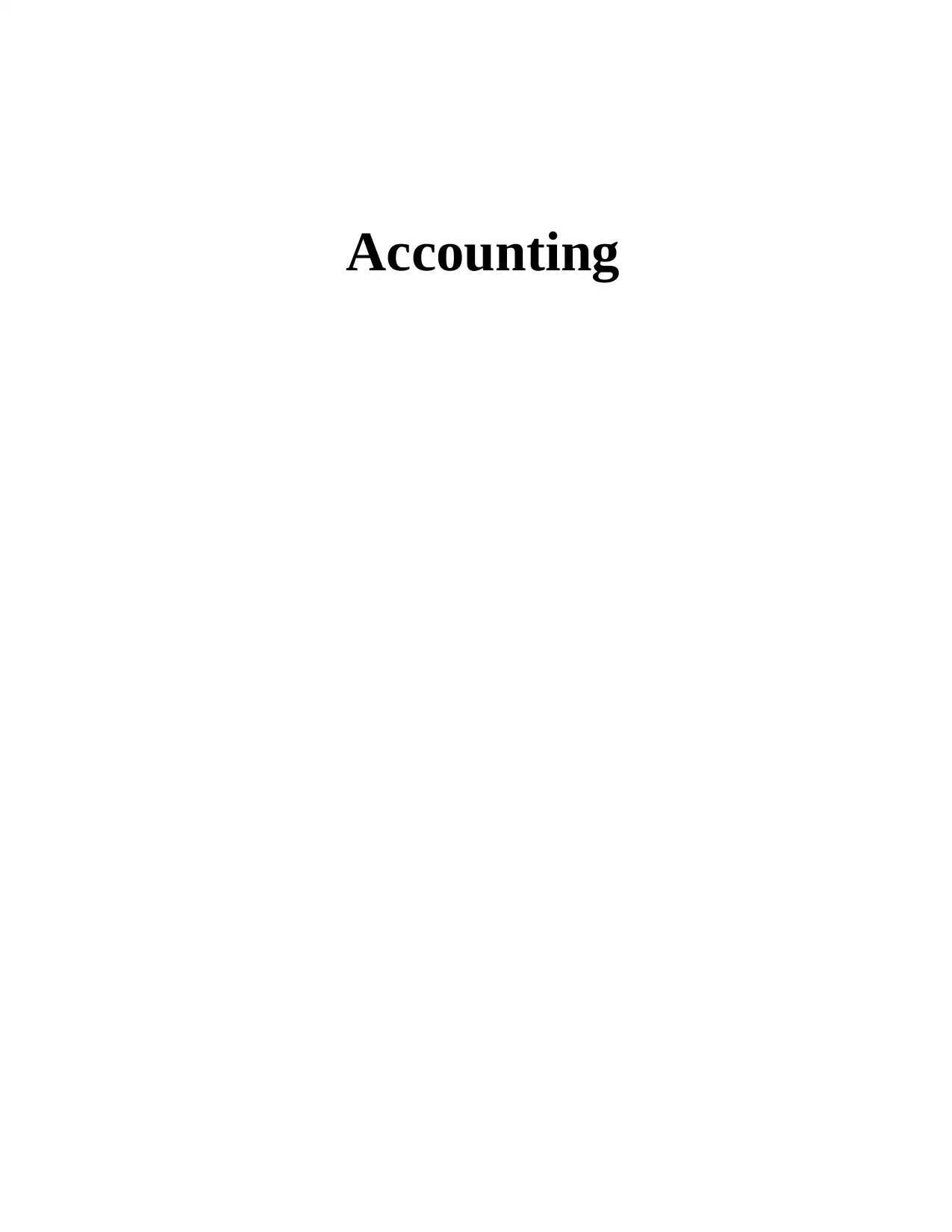
Accounting
Paraphrase This Document
Need a fresh take? Get an instant paraphrase of this document with our AI Paraphraser
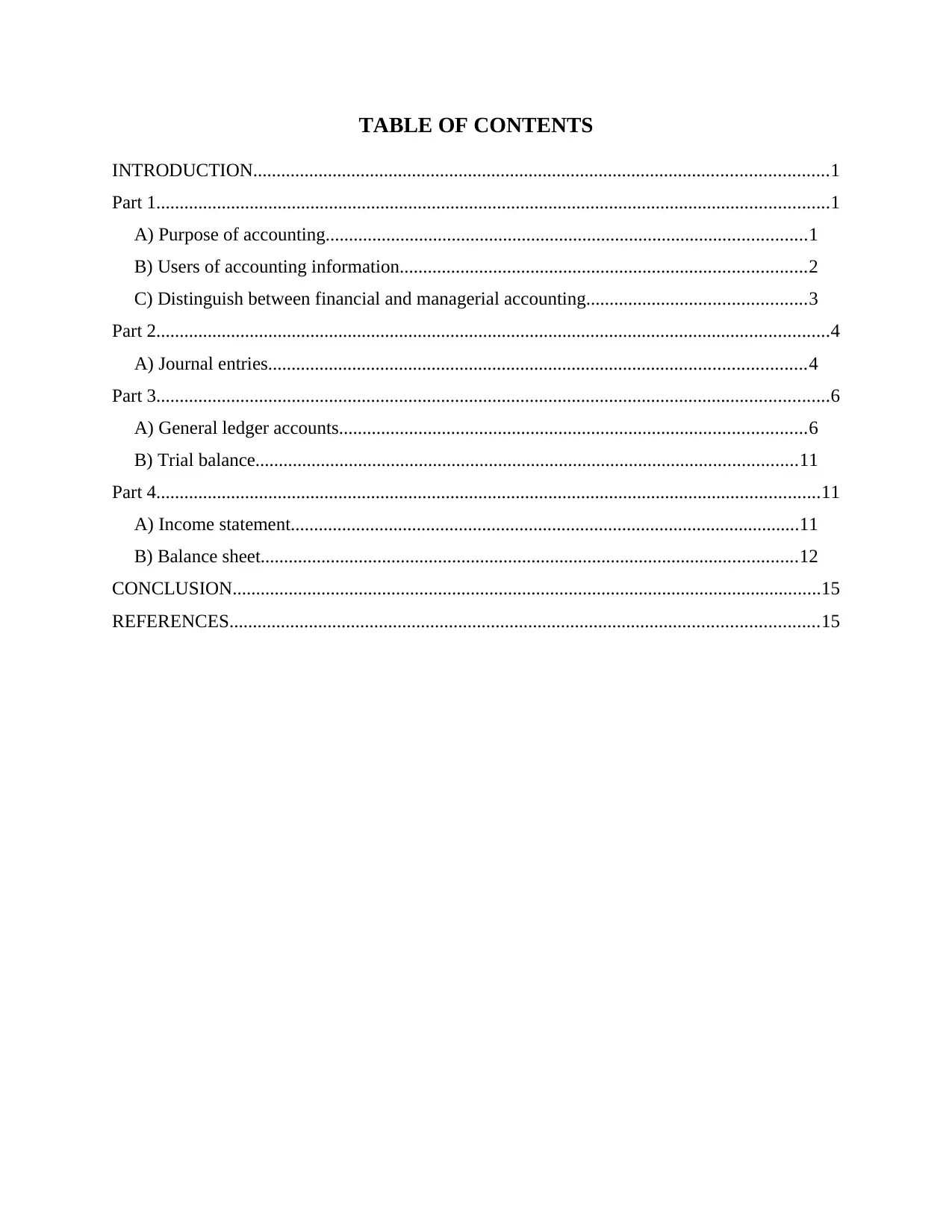
TABLE OF CONTENTS
INTRODUCTION...........................................................................................................................1
Part 1................................................................................................................................................1
A) Purpose of accounting.......................................................................................................1
B) Users of accounting information.......................................................................................2
C) Distinguish between financial and managerial accounting...............................................3
Part 2................................................................................................................................................4
A) Journal entries...................................................................................................................4
Part 3................................................................................................................................................6
A) General ledger accounts....................................................................................................6
B) Trial balance....................................................................................................................11
Part 4..............................................................................................................................................11
A) Income statement.............................................................................................................11
B) Balance sheet...................................................................................................................12
CONCLUSION..............................................................................................................................15
REFERENCES..............................................................................................................................15
INTRODUCTION...........................................................................................................................1
Part 1................................................................................................................................................1
A) Purpose of accounting.......................................................................................................1
B) Users of accounting information.......................................................................................2
C) Distinguish between financial and managerial accounting...............................................3
Part 2................................................................................................................................................4
A) Journal entries...................................................................................................................4
Part 3................................................................................................................................................6
A) General ledger accounts....................................................................................................6
B) Trial balance....................................................................................................................11
Part 4..............................................................................................................................................11
A) Income statement.............................................................................................................11
B) Balance sheet...................................................................................................................12
CONCLUSION..............................................................................................................................15
REFERENCES..............................................................................................................................15
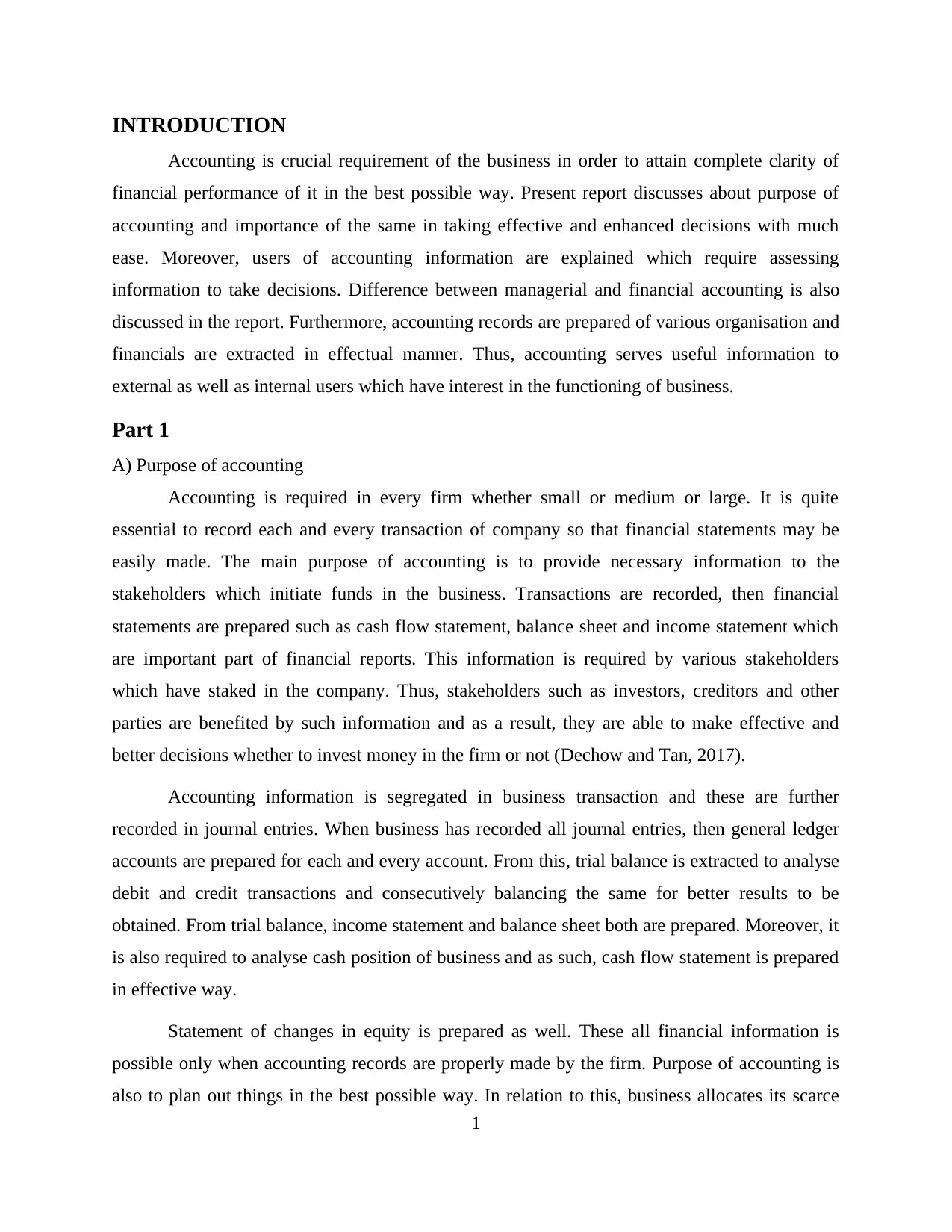
INTRODUCTION
Accounting is crucial requirement of the business in order to attain complete clarity of
financial performance of it in the best possible way. Present report discusses about purpose of
accounting and importance of the same in taking effective and enhanced decisions with much
ease. Moreover, users of accounting information are explained which require assessing
information to take decisions. Difference between managerial and financial accounting is also
discussed in the report. Furthermore, accounting records are prepared of various organisation and
financials are extracted in effectual manner. Thus, accounting serves useful information to
external as well as internal users which have interest in the functioning of business.
Part 1
A) Purpose of accounting
Accounting is required in every firm whether small or medium or large. It is quite
essential to record each and every transaction of company so that financial statements may be
easily made. The main purpose of accounting is to provide necessary information to the
stakeholders which initiate funds in the business. Transactions are recorded, then financial
statements are prepared such as cash flow statement, balance sheet and income statement which
are important part of financial reports. This information is required by various stakeholders
which have staked in the company. Thus, stakeholders such as investors, creditors and other
parties are benefited by such information and as a result, they are able to make effective and
better decisions whether to invest money in the firm or not (Dechow and Tan, 2017).
Accounting information is segregated in business transaction and these are further
recorded in journal entries. When business has recorded all journal entries, then general ledger
accounts are prepared for each and every account. From this, trial balance is extracted to analyse
debit and credit transactions and consecutively balancing the same for better results to be
obtained. From trial balance, income statement and balance sheet both are prepared. Moreover, it
is also required to analyse cash position of business and as such, cash flow statement is prepared
in effective way.
Statement of changes in equity is prepared as well. These all financial information is
possible only when accounting records are properly made by the firm. Purpose of accounting is
also to plan out things in the best possible way. In relation to this, business allocates its scarce
1
Accounting is crucial requirement of the business in order to attain complete clarity of
financial performance of it in the best possible way. Present report discusses about purpose of
accounting and importance of the same in taking effective and enhanced decisions with much
ease. Moreover, users of accounting information are explained which require assessing
information to take decisions. Difference between managerial and financial accounting is also
discussed in the report. Furthermore, accounting records are prepared of various organisation and
financials are extracted in effectual manner. Thus, accounting serves useful information to
external as well as internal users which have interest in the functioning of business.
Part 1
A) Purpose of accounting
Accounting is required in every firm whether small or medium or large. It is quite
essential to record each and every transaction of company so that financial statements may be
easily made. The main purpose of accounting is to provide necessary information to the
stakeholders which initiate funds in the business. Transactions are recorded, then financial
statements are prepared such as cash flow statement, balance sheet and income statement which
are important part of financial reports. This information is required by various stakeholders
which have staked in the company. Thus, stakeholders such as investors, creditors and other
parties are benefited by such information and as a result, they are able to make effective and
better decisions whether to invest money in the firm or not (Dechow and Tan, 2017).
Accounting information is segregated in business transaction and these are further
recorded in journal entries. When business has recorded all journal entries, then general ledger
accounts are prepared for each and every account. From this, trial balance is extracted to analyse
debit and credit transactions and consecutively balancing the same for better results to be
obtained. From trial balance, income statement and balance sheet both are prepared. Moreover, it
is also required to analyse cash position of business and as such, cash flow statement is prepared
in effective way.
Statement of changes in equity is prepared as well. These all financial information is
possible only when accounting records are properly made by the firm. Purpose of accounting is
also to plan out things in the best possible way. In relation to this, business allocates its scarce
1
⊘ This is a preview!⊘
Do you want full access?
Subscribe today to unlock all pages.

Trusted by 1+ million students worldwide
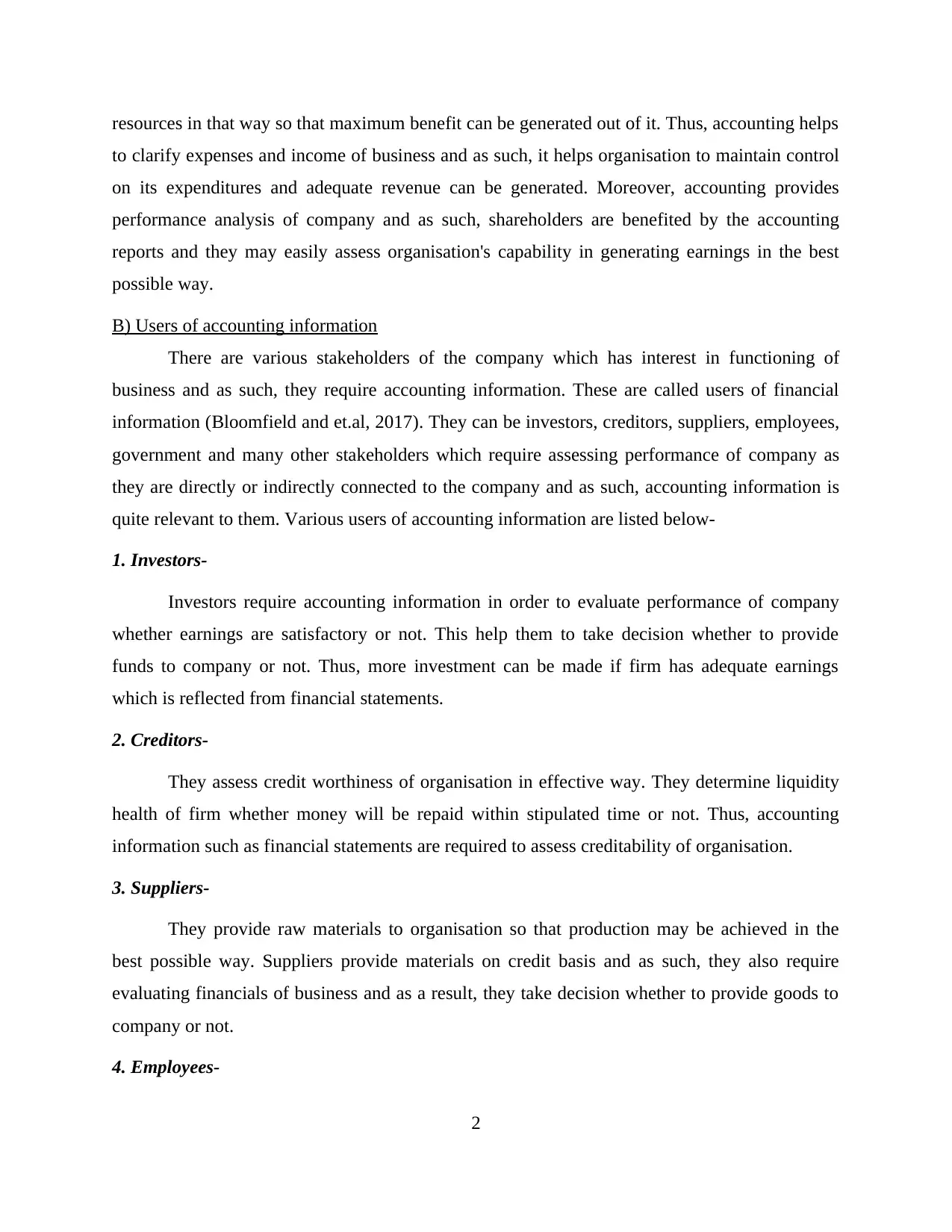
resources in that way so that maximum benefit can be generated out of it. Thus, accounting helps
to clarify expenses and income of business and as such, it helps organisation to maintain control
on its expenditures and adequate revenue can be generated. Moreover, accounting provides
performance analysis of company and as such, shareholders are benefited by the accounting
reports and they may easily assess organisation's capability in generating earnings in the best
possible way.
B) Users of accounting information
There are various stakeholders of the company which has interest in functioning of
business and as such, they require accounting information. These are called users of financial
information (Bloomfield and et.al, 2017). They can be investors, creditors, suppliers, employees,
government and many other stakeholders which require assessing performance of company as
they are directly or indirectly connected to the company and as such, accounting information is
quite relevant to them. Various users of accounting information are listed below-
1. Investors-
Investors require accounting information in order to evaluate performance of company
whether earnings are satisfactory or not. This help them to take decision whether to provide
funds to company or not. Thus, more investment can be made if firm has adequate earnings
which is reflected from financial statements.
2. Creditors-
They assess credit worthiness of organisation in effective way. They determine liquidity
health of firm whether money will be repaid within stipulated time or not. Thus, accounting
information such as financial statements are required to assess creditability of organisation.
3. Suppliers-
They provide raw materials to organisation so that production may be achieved in the
best possible way. Suppliers provide materials on credit basis and as such, they also require
evaluating financials of business and as a result, they take decision whether to provide goods to
company or not.
4. Employees-
2
to clarify expenses and income of business and as such, it helps organisation to maintain control
on its expenditures and adequate revenue can be generated. Moreover, accounting provides
performance analysis of company and as such, shareholders are benefited by the accounting
reports and they may easily assess organisation's capability in generating earnings in the best
possible way.
B) Users of accounting information
There are various stakeholders of the company which has interest in functioning of
business and as such, they require accounting information. These are called users of financial
information (Bloomfield and et.al, 2017). They can be investors, creditors, suppliers, employees,
government and many other stakeholders which require assessing performance of company as
they are directly or indirectly connected to the company and as such, accounting information is
quite relevant to them. Various users of accounting information are listed below-
1. Investors-
Investors require accounting information in order to evaluate performance of company
whether earnings are satisfactory or not. This help them to take decision whether to provide
funds to company or not. Thus, more investment can be made if firm has adequate earnings
which is reflected from financial statements.
2. Creditors-
They assess credit worthiness of organisation in effective way. They determine liquidity
health of firm whether money will be repaid within stipulated time or not. Thus, accounting
information such as financial statements are required to assess creditability of organisation.
3. Suppliers-
They provide raw materials to organisation so that production may be achieved in the
best possible way. Suppliers provide materials on credit basis and as such, they also require
evaluating financials of business and as a result, they take decision whether to provide goods to
company or not.
4. Employees-
2
Paraphrase This Document
Need a fresh take? Get an instant paraphrase of this document with our AI Paraphraser
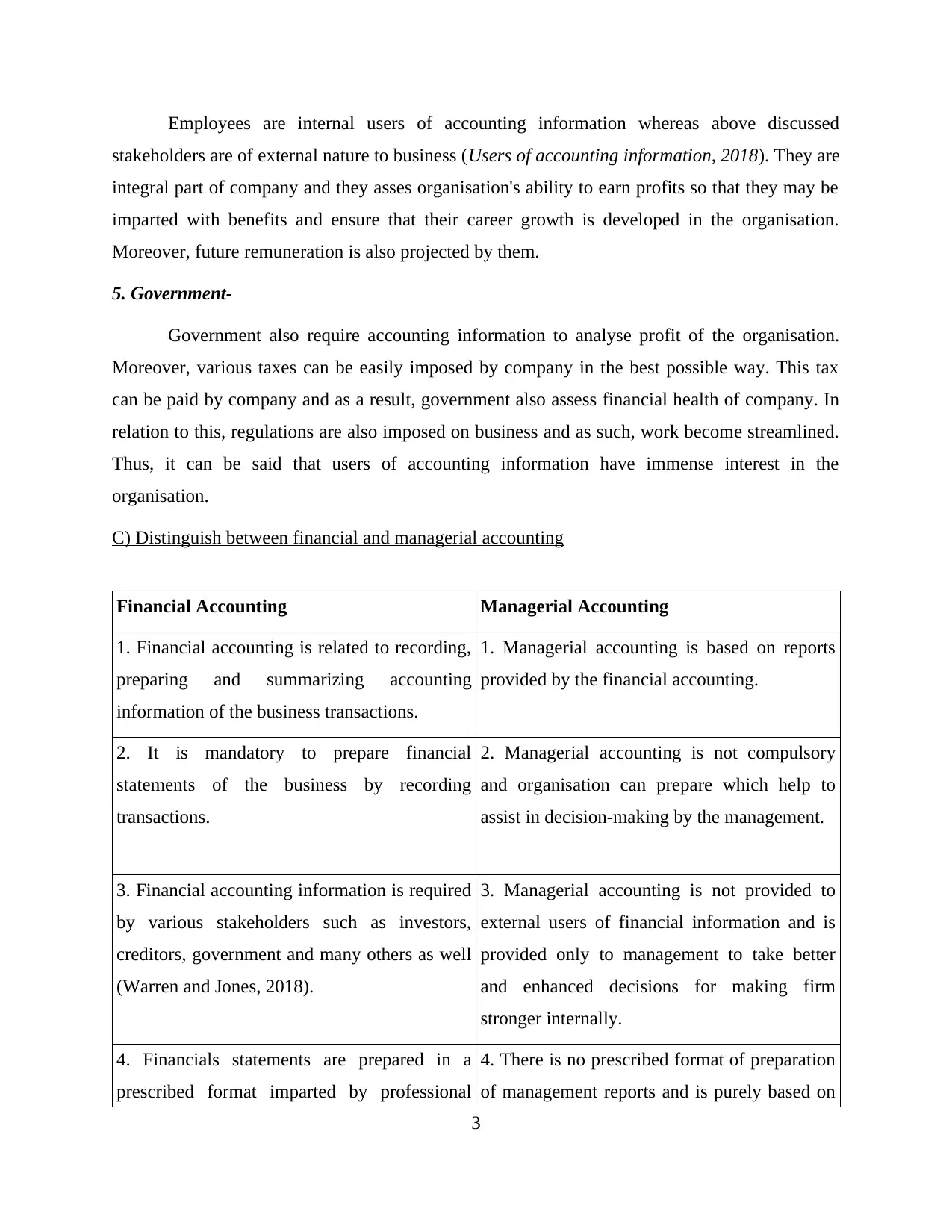
Employees are internal users of accounting information whereas above discussed
stakeholders are of external nature to business (Users of accounting information, 2018). They are
integral part of company and they asses organisation's ability to earn profits so that they may be
imparted with benefits and ensure that their career growth is developed in the organisation.
Moreover, future remuneration is also projected by them.
5. Government-
Government also require accounting information to analyse profit of the organisation.
Moreover, various taxes can be easily imposed by company in the best possible way. This tax
can be paid by company and as a result, government also assess financial health of company. In
relation to this, regulations are also imposed on business and as such, work become streamlined.
Thus, it can be said that users of accounting information have immense interest in the
organisation.
C) Distinguish between financial and managerial accounting
Financial Accounting Managerial Accounting
1. Financial accounting is related to recording,
preparing and summarizing accounting
information of the business transactions.
1. Managerial accounting is based on reports
provided by the financial accounting.
2. It is mandatory to prepare financial
statements of the business by recording
transactions.
2. Managerial accounting is not compulsory
and organisation can prepare which help to
assist in decision-making by the management.
3. Financial accounting information is required
by various stakeholders such as investors,
creditors, government and many others as well
(Warren and Jones, 2018).
3. Managerial accounting is not provided to
external users of financial information and is
provided only to management to take better
and enhanced decisions for making firm
stronger internally.
4. Financials statements are prepared in a
prescribed format imparted by professional
4. There is no prescribed format of preparation
of management reports and is purely based on
3
stakeholders are of external nature to business (Users of accounting information, 2018). They are
integral part of company and they asses organisation's ability to earn profits so that they may be
imparted with benefits and ensure that their career growth is developed in the organisation.
Moreover, future remuneration is also projected by them.
5. Government-
Government also require accounting information to analyse profit of the organisation.
Moreover, various taxes can be easily imposed by company in the best possible way. This tax
can be paid by company and as a result, government also assess financial health of company. In
relation to this, regulations are also imposed on business and as such, work become streamlined.
Thus, it can be said that users of accounting information have immense interest in the
organisation.
C) Distinguish between financial and managerial accounting
Financial Accounting Managerial Accounting
1. Financial accounting is related to recording,
preparing and summarizing accounting
information of the business transactions.
1. Managerial accounting is based on reports
provided by the financial accounting.
2. It is mandatory to prepare financial
statements of the business by recording
transactions.
2. Managerial accounting is not compulsory
and organisation can prepare which help to
assist in decision-making by the management.
3. Financial accounting information is required
by various stakeholders such as investors,
creditors, government and many others as well
(Warren and Jones, 2018).
3. Managerial accounting is not provided to
external users of financial information and is
provided only to management to take better
and enhanced decisions for making firm
stronger internally.
4. Financials statements are prepared in a
prescribed format imparted by professional
4. There is no prescribed format of preparation
of management reports and is purely based on
3
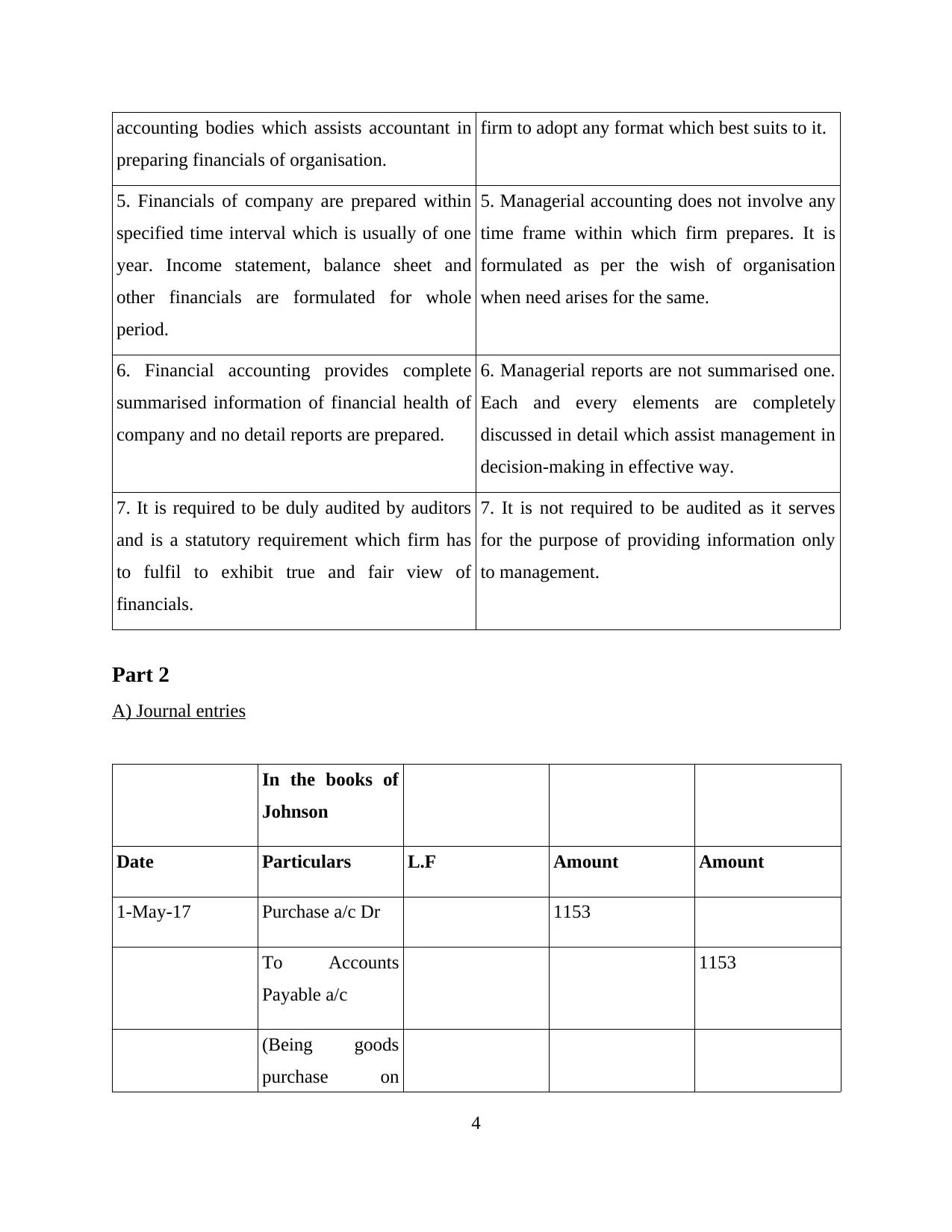
accounting bodies which assists accountant in
preparing financials of organisation.
firm to adopt any format which best suits to it.
5. Financials of company are prepared within
specified time interval which is usually of one
year. Income statement, balance sheet and
other financials are formulated for whole
period.
5. Managerial accounting does not involve any
time frame within which firm prepares. It is
formulated as per the wish of organisation
when need arises for the same.
6. Financial accounting provides complete
summarised information of financial health of
company and no detail reports are prepared.
6. Managerial reports are not summarised one.
Each and every elements are completely
discussed in detail which assist management in
decision-making in effective way.
7. It is required to be duly audited by auditors
and is a statutory requirement which firm has
to fulfil to exhibit true and fair view of
financials.
7. It is not required to be audited as it serves
for the purpose of providing information only
to management.
Part 2
A) Journal entries
In the books of
Johnson
Date Particulars L.F Amount Amount
1-May-17 Purchase a/c Dr 1153
To Accounts
Payable a/c
1153
(Being goods
purchase on
4
preparing financials of organisation.
firm to adopt any format which best suits to it.
5. Financials of company are prepared within
specified time interval which is usually of one
year. Income statement, balance sheet and
other financials are formulated for whole
period.
5. Managerial accounting does not involve any
time frame within which firm prepares. It is
formulated as per the wish of organisation
when need arises for the same.
6. Financial accounting provides complete
summarised information of financial health of
company and no detail reports are prepared.
6. Managerial reports are not summarised one.
Each and every elements are completely
discussed in detail which assist management in
decision-making in effective way.
7. It is required to be duly audited by auditors
and is a statutory requirement which firm has
to fulfil to exhibit true and fair view of
financials.
7. It is not required to be audited as it serves
for the purpose of providing information only
to management.
Part 2
A) Journal entries
In the books of
Johnson
Date Particulars L.F Amount Amount
1-May-17 Purchase a/c Dr 1153
To Accounts
Payable a/c
1153
(Being goods
purchase on
4
⊘ This is a preview!⊘
Do you want full access?
Subscribe today to unlock all pages.

Trusted by 1+ million students worldwide
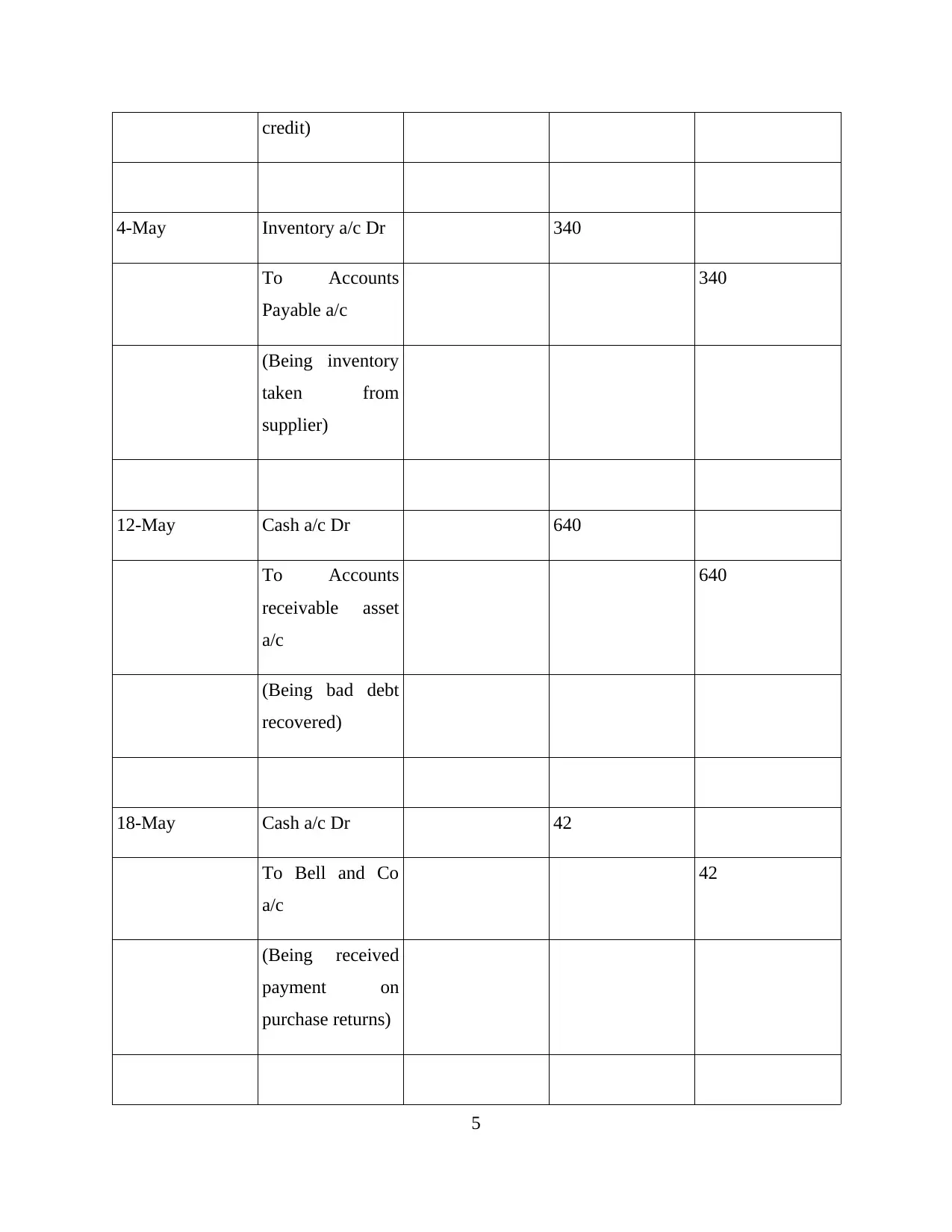
credit)
4-May Inventory a/c Dr 340
To Accounts
Payable a/c
340
(Being inventory
taken from
supplier)
12-May Cash a/c Dr 640
To Accounts
receivable asset
a/c
640
(Being bad debt
recovered)
18-May Cash a/c Dr 42
To Bell and Co
a/c
42
(Being received
payment on
purchase returns)
5
4-May Inventory a/c Dr 340
To Accounts
Payable a/c
340
(Being inventory
taken from
supplier)
12-May Cash a/c Dr 640
To Accounts
receivable asset
a/c
640
(Being bad debt
recovered)
18-May Cash a/c Dr 42
To Bell and Co
a/c
42
(Being received
payment on
purchase returns)
5
Paraphrase This Document
Need a fresh take? Get an instant paraphrase of this document with our AI Paraphraser
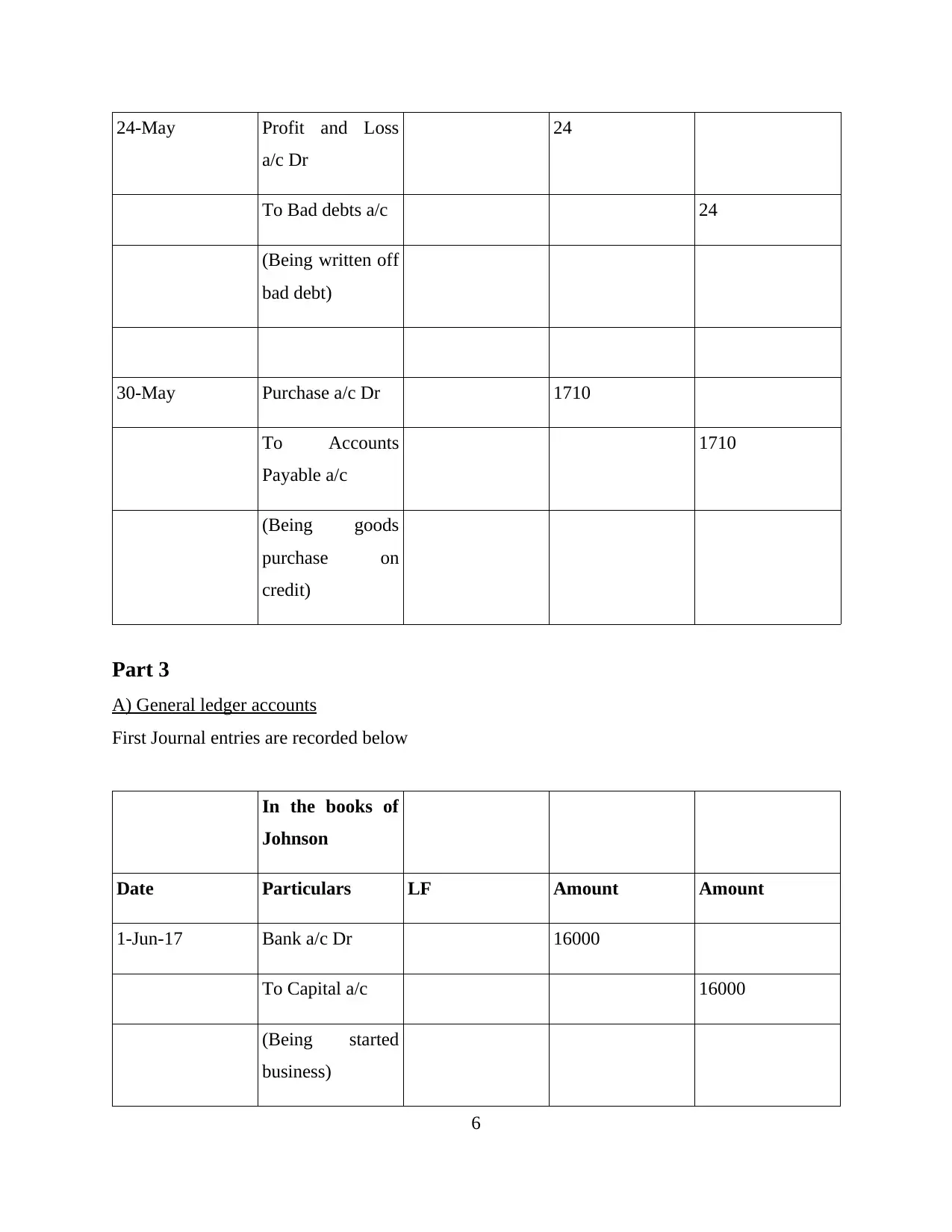
24-May Profit and Loss
a/c Dr
24
To Bad debts a/c 24
(Being written off
bad debt)
30-May Purchase a/c Dr 1710
To Accounts
Payable a/c
1710
(Being goods
purchase on
credit)
Part 3
A) General ledger accounts
First Journal entries are recorded below
In the books of
Johnson
Date Particulars LF Amount Amount
1-Jun-17 Bank a/c Dr 16000
To Capital a/c 16000
(Being started
business)
6
a/c Dr
24
To Bad debts a/c 24
(Being written off
bad debt)
30-May Purchase a/c Dr 1710
To Accounts
Payable a/c
1710
(Being goods
purchase on
credit)
Part 3
A) General ledger accounts
First Journal entries are recorded below
In the books of
Johnson
Date Particulars LF Amount Amount
1-Jun-17 Bank a/c Dr 16000
To Capital a/c 16000
(Being started
business)
6
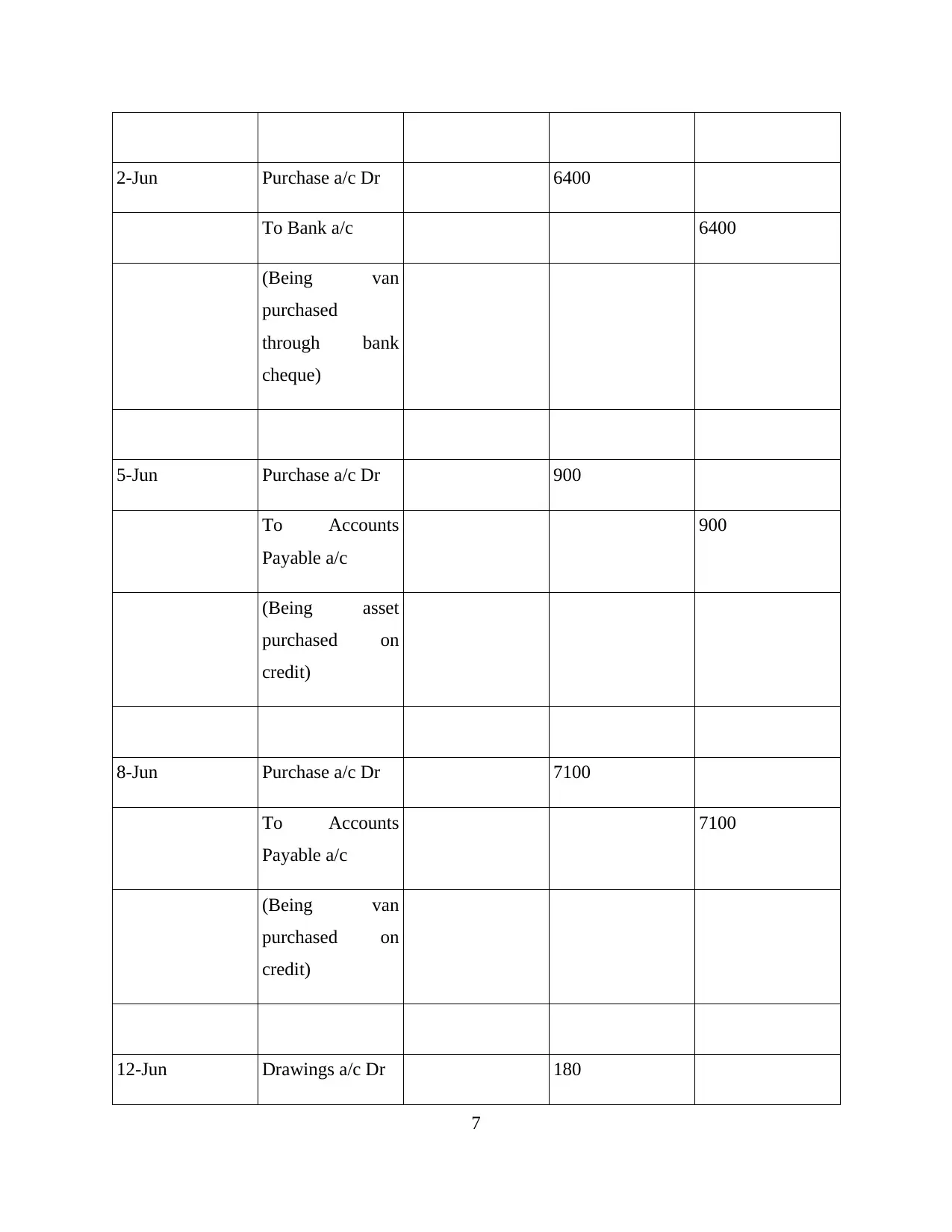
2-Jun Purchase a/c Dr 6400
To Bank a/c 6400
(Being van
purchased
through bank
cheque)
5-Jun Purchase a/c Dr 900
To Accounts
Payable a/c
900
(Being asset
purchased on
credit)
8-Jun Purchase a/c Dr 7100
To Accounts
Payable a/c
7100
(Being van
purchased on
credit)
12-Jun Drawings a/c Dr 180
7
To Bank a/c 6400
(Being van
purchased
through bank
cheque)
5-Jun Purchase a/c Dr 900
To Accounts
Payable a/c
900
(Being asset
purchased on
credit)
8-Jun Purchase a/c Dr 7100
To Accounts
Payable a/c
7100
(Being van
purchased on
credit)
12-Jun Drawings a/c Dr 180
7
⊘ This is a preview!⊘
Do you want full access?
Subscribe today to unlock all pages.

Trusted by 1+ million students worldwide
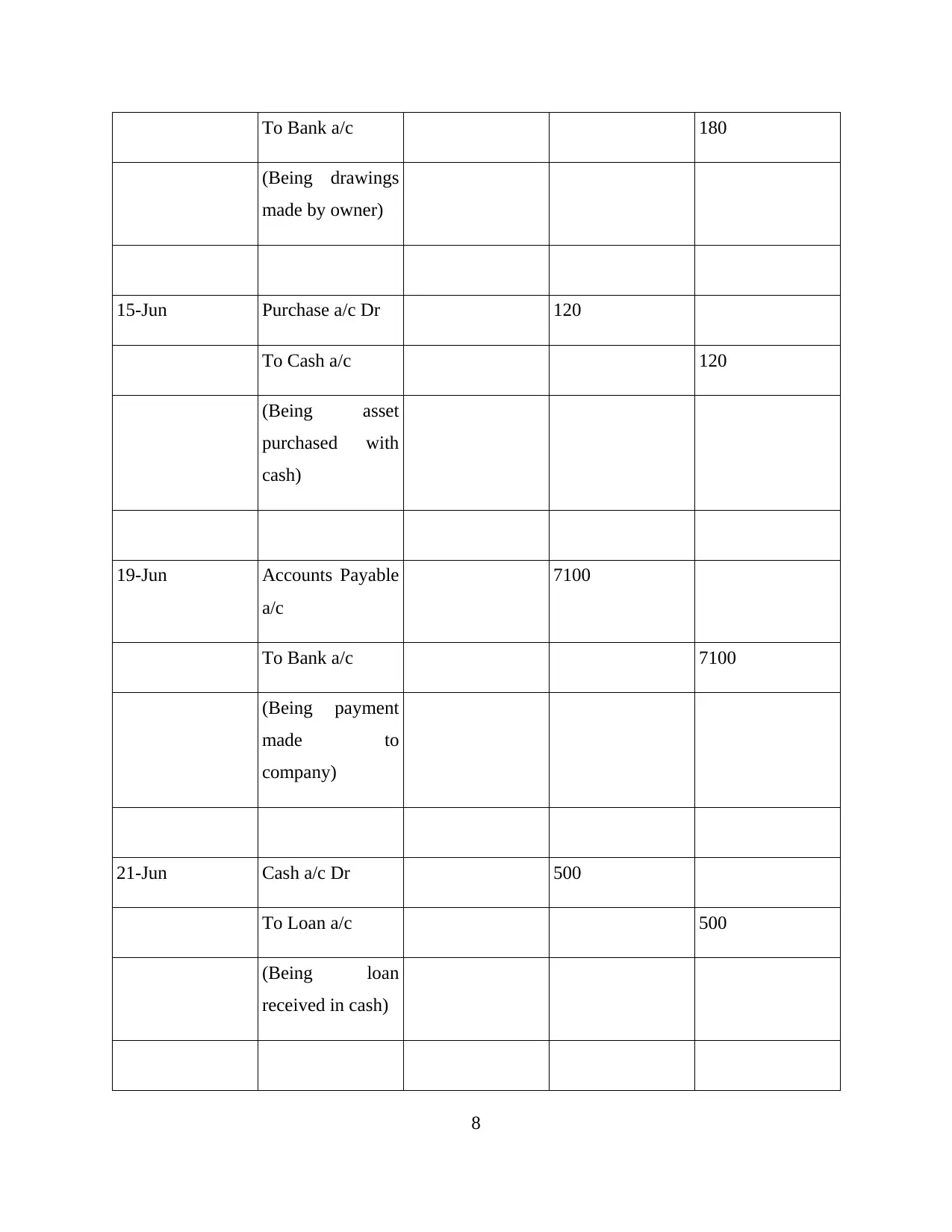
To Bank a/c 180
(Being drawings
made by owner)
15-Jun Purchase a/c Dr 120
To Cash a/c 120
(Being asset
purchased with
cash)
19-Jun Accounts Payable
a/c
7100
To Bank a/c 7100
(Being payment
made to
company)
21-Jun Cash a/c Dr 500
To Loan a/c 500
(Being loan
received in cash)
8
(Being drawings
made by owner)
15-Jun Purchase a/c Dr 120
To Cash a/c 120
(Being asset
purchased with
cash)
19-Jun Accounts Payable
a/c
7100
To Bank a/c 7100
(Being payment
made to
company)
21-Jun Cash a/c Dr 500
To Loan a/c 500
(Being loan
received in cash)
8
Paraphrase This Document
Need a fresh take? Get an instant paraphrase of this document with our AI Paraphraser
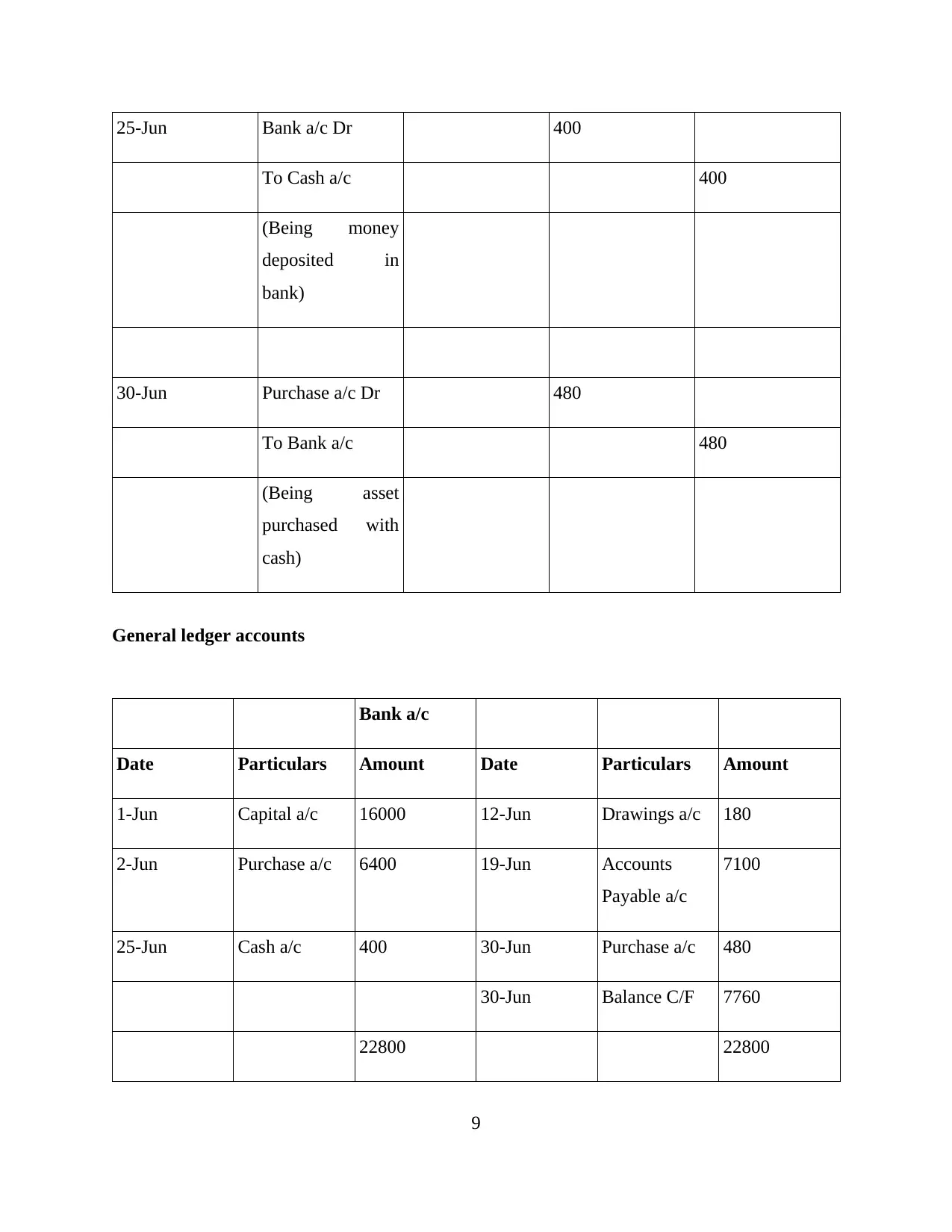
25-Jun Bank a/c Dr 400
To Cash a/c 400
(Being money
deposited in
bank)
30-Jun Purchase a/c Dr 480
To Bank a/c 480
(Being asset
purchased with
cash)
General ledger accounts
Bank a/c
Date Particulars Amount Date Particulars Amount
1-Jun Capital a/c 16000 12-Jun Drawings a/c 180
2-Jun Purchase a/c 6400 19-Jun Accounts
Payable a/c
7100
25-Jun Cash a/c 400 30-Jun Purchase a/c 480
30-Jun Balance C/F 7760
22800 22800
9
To Cash a/c 400
(Being money
deposited in
bank)
30-Jun Purchase a/c Dr 480
To Bank a/c 480
(Being asset
purchased with
cash)
General ledger accounts
Bank a/c
Date Particulars Amount Date Particulars Amount
1-Jun Capital a/c 16000 12-Jun Drawings a/c 180
2-Jun Purchase a/c 6400 19-Jun Accounts
Payable a/c
7100
25-Jun Cash a/c 400 30-Jun Purchase a/c 480
30-Jun Balance C/F 7760
22800 22800
9
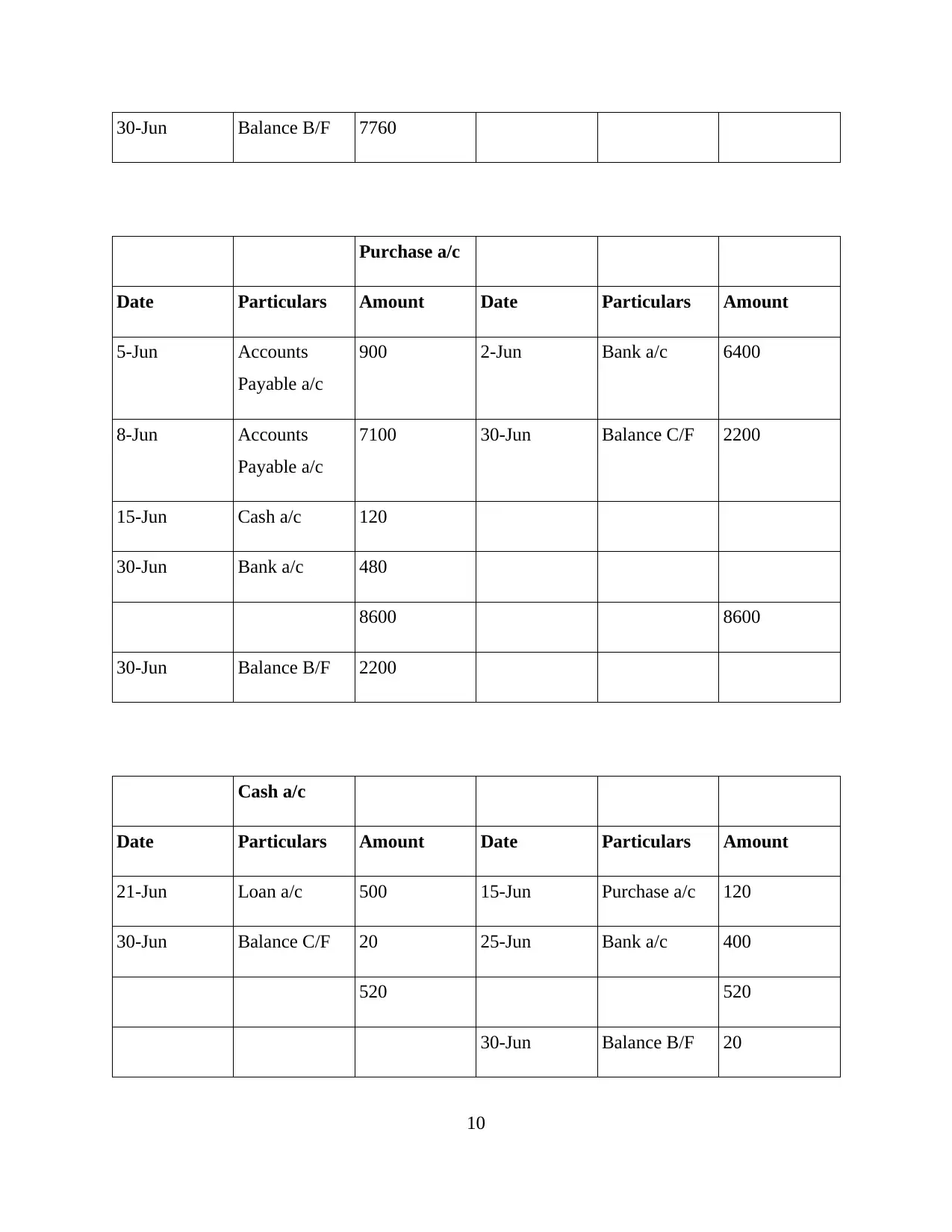
30-Jun Balance B/F 7760
Purchase a/c
Date Particulars Amount Date Particulars Amount
5-Jun Accounts
Payable a/c
900 2-Jun Bank a/c 6400
8-Jun Accounts
Payable a/c
7100 30-Jun Balance C/F 2200
15-Jun Cash a/c 120
30-Jun Bank a/c 480
8600 8600
30-Jun Balance B/F 2200
Cash a/c
Date Particulars Amount Date Particulars Amount
21-Jun Loan a/c 500 15-Jun Purchase a/c 120
30-Jun Balance C/F 20 25-Jun Bank a/c 400
520 520
30-Jun Balance B/F 20
10
Purchase a/c
Date Particulars Amount Date Particulars Amount
5-Jun Accounts
Payable a/c
900 2-Jun Bank a/c 6400
8-Jun Accounts
Payable a/c
7100 30-Jun Balance C/F 2200
15-Jun Cash a/c 120
30-Jun Bank a/c 480
8600 8600
30-Jun Balance B/F 2200
Cash a/c
Date Particulars Amount Date Particulars Amount
21-Jun Loan a/c 500 15-Jun Purchase a/c 120
30-Jun Balance C/F 20 25-Jun Bank a/c 400
520 520
30-Jun Balance B/F 20
10
⊘ This is a preview!⊘
Do you want full access?
Subscribe today to unlock all pages.

Trusted by 1+ million students worldwide
1 out of 18
Related Documents
Your All-in-One AI-Powered Toolkit for Academic Success.
+13062052269
info@desklib.com
Available 24*7 on WhatsApp / Email
![[object Object]](/_next/static/media/star-bottom.7253800d.svg)
Unlock your academic potential
Copyright © 2020–2025 A2Z Services. All Rights Reserved. Developed and managed by ZUCOL.





